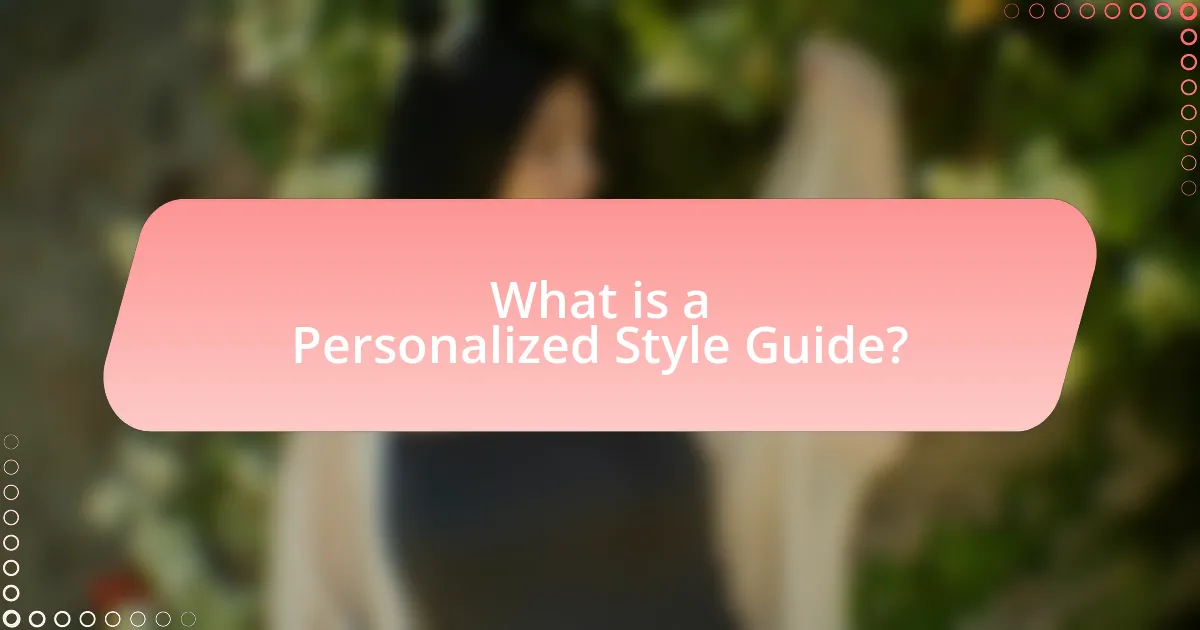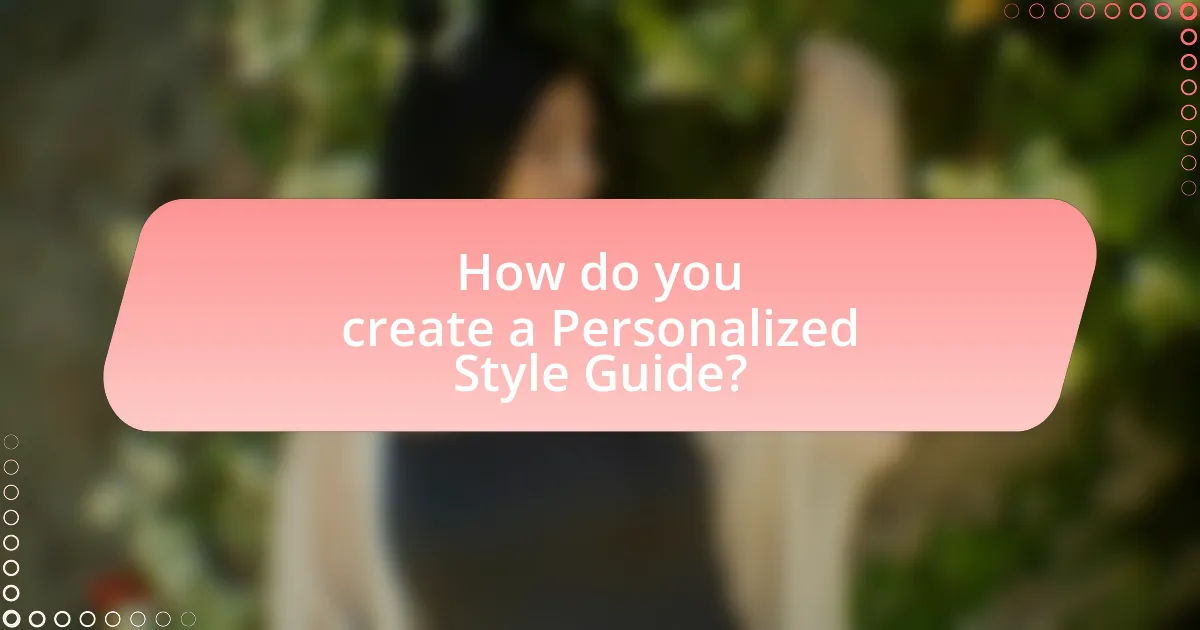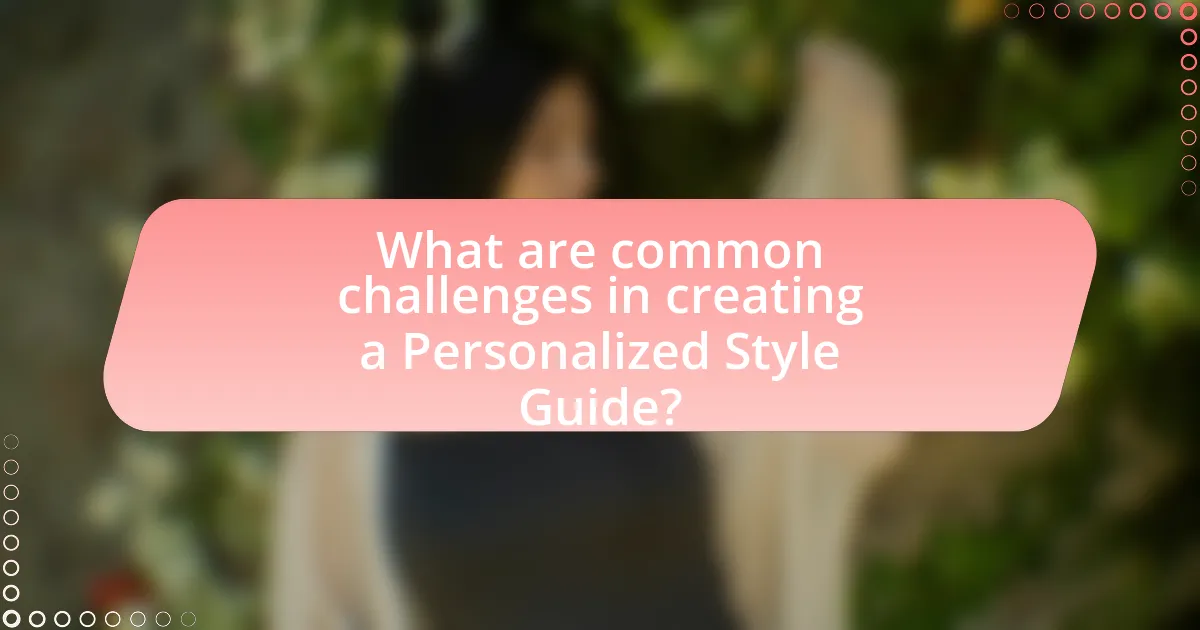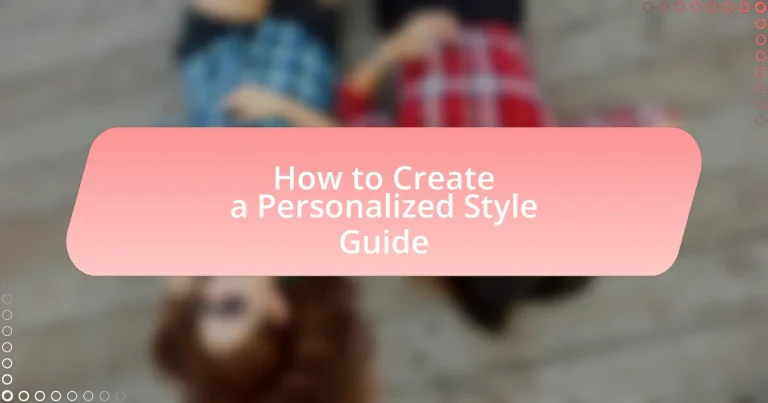A Personalized Style Guide is a tailored document that outlines specific preferences and standards for writing, design, and branding unique to an individual or organization. This guide is essential for ensuring consistency in communication and visual representation, enhancing brand recognition, and streamlining content creation. Key components include brand voice, typography, color palettes, and imagery guidelines, all of which contribute to a cohesive identity. The article details the importance of a Personalized Style Guide, the steps involved in creating one, common challenges faced during the process, and best practices for maintaining consistency and effectiveness.

What is a Personalized Style Guide?
A Personalized Style Guide is a tailored document that outlines specific preferences and standards for writing, design, and branding unique to an individual or organization. This guide serves to ensure consistency in communication and visual representation across various platforms and materials. For instance, it may include guidelines on tone, voice, typography, color schemes, and logo usage, which help maintain a cohesive identity. The effectiveness of a Personalized Style Guide is supported by its ability to streamline content creation and enhance brand recognition, as evidenced by companies that report improved clarity and professionalism in their communications when adhering to such guidelines.
Why is a Personalized Style Guide important?
A Personalized Style Guide is important because it ensures consistency in communication and branding across various platforms. Consistency enhances brand recognition and trust, as studies show that cohesive branding can increase revenue by up to 23%. Furthermore, a style guide provides clear guidelines for tone, language, and visual elements, which helps maintain a unified voice and reduces misunderstandings among team members. This structured approach not only streamlines the content creation process but also aligns all communications with the organization’s values and objectives.
How does a Personalized Style Guide enhance brand consistency?
A Personalized Style Guide enhances brand consistency by providing clear guidelines on visual and verbal elements that represent the brand. This guide ensures that all communications, whether written or visual, adhere to a unified tone, color palette, typography, and logo usage, which reinforces brand identity across various platforms. Research indicates that consistent branding can increase revenue by up to 23%, demonstrating the financial impact of maintaining a cohesive brand image. By standardizing these elements, a Personalized Style Guide minimizes discrepancies and fosters recognition, ultimately strengthening the brand’s presence in the market.
What role does a Personalized Style Guide play in communication?
A Personalized Style Guide plays a crucial role in communication by ensuring consistency and clarity in messaging. This guide establishes specific guidelines for language, tone, and formatting, which helps maintain a unified voice across various platforms and materials. For instance, organizations that implement a style guide can reduce misunderstandings and enhance brand identity, as seen in companies like Apple and Google, which utilize style guides to create cohesive communication strategies. By providing clear standards, a Personalized Style Guide facilitates effective communication among team members and with external audiences, ultimately leading to improved engagement and understanding.
What are the key components of a Personalized Style Guide?
The key components of a Personalized Style Guide include brand voice, typography, color palette, imagery guidelines, and usage rules. Brand voice defines the tone and personality of the communication, ensuring consistency across all platforms. Typography specifies the fonts and styles to be used, which contributes to the overall aesthetic and readability. The color palette outlines the primary and secondary colors that represent the brand, influencing visual identity. Imagery guidelines dictate the style and type of images to be used, reinforcing the brand’s message. Lastly, usage rules provide instructions on how to apply these elements correctly, ensuring adherence to the established style. These components collectively ensure a cohesive and recognizable brand presence.
What elements should be included in a typography section?
A typography section should include font families, font sizes, line heights, letter spacing, and color specifications. These elements define the visual hierarchy and readability of text within a design. For instance, specifying a primary font family, such as Arial or Times New Roman, along with corresponding sizes (e.g., 16px for body text) ensures consistency across various platforms. Additionally, line height (e.g., 1.5) and letter spacing (e.g., 0.5px) enhance legibility, while color specifications (e.g., hex codes for text color) maintain brand identity. Collectively, these elements create a cohesive and effective typography style that aligns with the overall design goals.
How can color palettes be effectively defined in a style guide?
Color palettes can be effectively defined in a style guide by establishing a clear set of primary, secondary, and accent colors that align with the brand’s identity. This involves selecting colors based on their psychological impact and cultural significance, ensuring they resonate with the target audience. For instance, a study by the Institute for Color Research found that color increases brand recognition by up to 80%, highlighting the importance of a well-defined palette. Additionally, providing color codes (such as HEX, RGB, and CMYK) ensures consistency across various media and applications, reinforcing the brand’s visual identity.

How do you create a Personalized Style Guide?
To create a Personalized Style Guide, begin by defining your brand’s voice and tone, which should reflect your organization’s values and target audience. Next, outline specific guidelines for language usage, including preferred vocabulary, grammar rules, and punctuation styles. Incorporate visual elements by specifying color palettes, typography, and logo usage to ensure consistency across all materials. Additionally, provide examples of do’s and don’ts to clarify expectations. This structured approach helps maintain a cohesive identity and enhances communication effectiveness.
What steps are involved in developing a Personalized Style Guide?
Developing a Personalized Style Guide involves several key steps. First, identify the purpose and audience of the guide to ensure it meets specific needs. Next, gather existing materials and analyze them for consistency in tone, voice, and formatting. Then, establish guidelines for language usage, including grammar, punctuation, and terminology specific to the brand or individual. After that, create a visual style section that outlines typography, color schemes, and logo usage. Finally, review and revise the guide based on feedback from stakeholders to ensure clarity and effectiveness. These steps are essential for creating a comprehensive and functional style guide that aligns with the intended goals.
How do you assess your current branding and style needs?
To assess current branding and style needs, conduct a comprehensive evaluation of existing brand elements, including visual identity, messaging, and audience perception. This involves analyzing brand consistency across platforms, gathering feedback from stakeholders, and reviewing market trends to identify gaps or areas for improvement. For instance, a study by Nielsen found that consistent branding can increase revenue by 23%, highlighting the importance of aligning branding with audience expectations and market standards.
What methods can be used to gather input from stakeholders?
Methods to gather input from stakeholders include surveys, interviews, focus groups, and workshops. Surveys allow for quantitative data collection from a larger audience, while interviews provide in-depth qualitative insights from key individuals. Focus groups facilitate discussions among diverse stakeholders to explore different perspectives, and workshops encourage collaborative brainstorming and idea generation. These methods are effective as they engage stakeholders directly, ensuring their voices are heard and considered in the decision-making process.
How can you ensure your Personalized Style Guide is effective?
To ensure your Personalized Style Guide is effective, establish clear guidelines that reflect your brand’s voice and visual identity. This involves defining specific elements such as tone, vocabulary, grammar rules, and design preferences that align with your target audience’s expectations. Research indicates that brands with consistent style guides experience a 23% increase in customer engagement, demonstrating the importance of clarity and consistency in communication. Regularly review and update the guide based on feedback and evolving brand needs to maintain its relevance and effectiveness.
What strategies can be implemented for testing the guide’s usability?
To test the guide’s usability, implement strategies such as user testing, heuristic evaluation, and A/B testing. User testing involves observing real users as they interact with the guide, allowing for the identification of pain points and areas for improvement. Heuristic evaluation entails experts reviewing the guide against established usability principles, ensuring it meets best practices. A/B testing allows for comparing two versions of the guide to determine which one performs better in terms of user engagement and comprehension. These strategies are effective as they provide direct feedback from users and experts, leading to actionable insights for enhancing usability.
How often should a Personalized Style Guide be updated?
A Personalized Style Guide should be updated at least annually or whenever significant changes occur in branding, audience, or content strategy. Regular updates ensure that the guide remains relevant and aligned with the evolving identity and goals of the organization. For instance, a study by the Content Marketing Institute indicates that 70% of successful brands regularly review and revise their style guidelines to maintain consistency and effectiveness in communication.

What are common challenges in creating a Personalized Style Guide?
Common challenges in creating a Personalized Style Guide include ensuring consistency across various platforms, aligning the guide with the brand’s identity, and accommodating diverse audience preferences. Consistency is crucial because discrepancies can confuse users and dilute brand messaging. Aligning the guide with the brand’s identity requires a deep understanding of the brand’s values and voice, which can be difficult to articulate clearly. Additionally, accommodating diverse audience preferences necessitates extensive research and adaptability, as different segments may have varying expectations and interpretations of style. These challenges highlight the complexity involved in developing a comprehensive and effective Personalized Style Guide.
What obstacles might you face during the creation process?
During the creation process of a personalized style guide, common obstacles include a lack of clarity in brand identity, inconsistent application of style elements, and difficulty in gathering input from stakeholders. A lack of clarity in brand identity can lead to confusion about the guide’s purpose, making it challenging to establish a cohesive style. Inconsistent application of style elements may result from differing interpretations of guidelines, which can undermine the guide’s effectiveness. Additionally, difficulty in gathering input from stakeholders can hinder the development process, as diverse perspectives are essential for creating a comprehensive guide. These obstacles can significantly impact the quality and usability of the final style guide.
How can conflicting opinions be managed among team members?
Conflicting opinions among team members can be managed through structured communication and conflict resolution strategies. Implementing regular team meetings allows members to express their viewpoints in a controlled environment, fostering open dialogue. Techniques such as active listening and encouraging empathy can help team members understand differing perspectives. Research indicates that teams that engage in constructive conflict resolution are 25% more effective in achieving their goals, as they leverage diverse opinions to enhance creativity and problem-solving. By establishing clear guidelines for discussions and promoting a culture of respect, teams can effectively navigate conflicts and reach consensus.
What are the risks of not adhering to the style guide?
Not adhering to the style guide can lead to inconsistencies in branding, communication, and overall quality of content. These inconsistencies can confuse the audience, dilute the brand message, and undermine credibility. For instance, a study by the Nielsen Norman Group found that inconsistent design can lead to a 50% increase in user errors, highlighting the importance of uniformity in style. Additionally, failure to follow a style guide can result in increased revision time and costs, as teams may need to spend extra effort to correct discrepancies.
How can you overcome these challenges?
To overcome challenges in creating a personalized style guide, one can implement a structured approach that includes thorough research, stakeholder collaboration, and iterative feedback. Conducting comprehensive research on existing style guides and best practices provides a solid foundation. Engaging stakeholders, such as team members and users, ensures that the guide meets diverse needs and perspectives. Additionally, incorporating iterative feedback allows for continuous improvement, making the guide more effective and user-friendly. This method is supported by studies indicating that collaborative and iterative processes lead to higher satisfaction and usability in design projects.
What best practices can help in maintaining consistency?
Establishing clear guidelines is essential for maintaining consistency in a personalized style guide. These guidelines should include specific rules for tone, voice, formatting, and terminology to ensure uniformity across all content. For instance, using a standardized template for documents can help reinforce visual consistency, while a glossary of terms can prevent variations in language. Research indicates that organizations with defined style guides experience a 25% increase in content clarity and coherence, which supports the effectiveness of these practices in achieving consistency.
How can feedback loops improve the style guide’s effectiveness?
Feedback loops can significantly enhance the effectiveness of a style guide by ensuring continuous improvement and adaptation to user needs. By collecting and analyzing user feedback on the style guide’s clarity, usability, and relevance, organizations can identify areas for refinement. For instance, a study by the Nielsen Norman Group highlights that iterative design processes, which include feedback loops, lead to a 50% increase in user satisfaction and usability. This evidence supports the notion that incorporating feedback mechanisms allows for real-time adjustments, making the style guide more aligned with the actual practices and preferences of its users.
What are some practical tips for implementing a Personalized Style Guide?
To implement a Personalized Style Guide effectively, begin by clearly defining the target audience and their preferences. Understanding the audience allows for tailored language, tone, and visual elements that resonate with them. Next, establish specific guidelines for writing style, including grammar, punctuation, and formatting rules, ensuring consistency across all communications. Incorporate examples of preferred and non-preferred styles to provide clarity. Additionally, create a centralized document that is easily accessible to all team members, facilitating adherence to the guide. Regularly review and update the guide based on feedback and evolving brand needs to maintain relevance. These steps are supported by research indicating that consistent branding can increase revenue by up to 23%, highlighting the importance of a well-implemented style guide.


